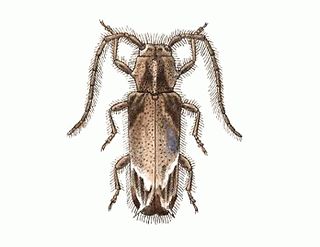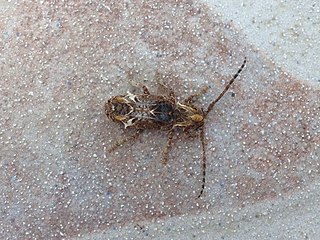
The Somabrachyidae are a family of moths in the order Lepidoptera. Other than Somabrachys aegrota, which also occurs in Spain and on Sicily, the family is Afrotropical.

Cechenena is a genus of moths in the family Sphingidae first described by Walter Rothschild and Karl Jordan in 1903.
Metula aegrota is a species of sea snail, a marine gastropod mollusk in the family Colubrariidae.

Cechenena aegrota, the mottled green hawkmoth, is a species of moth in the family Sphingidae. It was described by Arthur Gardiner Butler in 1875. It is known from Nepal, north-eastern India, Bangladesh, Thailand, Laos, southern China and Vietnam.

Asaphodes aegrota, also known as the dull brown looper, is a species of moth in the family Geometridae. It was first described by Arthur Gardiner Butler in 1879 as Selidosema aegrota. It is endemic to New Zealand and can be found in the North, South and Stewart Islands. This species inhabits open spaces in lowland native forest. The larvae of A. aegrota feed on native herbs and have also been observed feeding of the introduced lawn daisy. The adults are variable in appearance with the markings on both sides of its wings varying in intensity. Some populations also have narrow winged females. Adults are on the wing from November until March.

Desmiphora is a genus of longhorn beetles of the subfamily Lamiinae, containing the following species:
Desmiphora amioca is a species of beetle in the family Cerambycidae. It was described by Galileo and Martins in 1998. It is known from Brazil.
Desmiphora neoflavescens is a species of beetle in the family Cerambycidae. It was described by Galileo and Martins in 1998. It is known from Brazil.
Desmiphora santossilvai is a species of beetle in the family Cerambycidae. It was described by Galileo and Martins in 2003. It is known from Brazil and French Guiana.
Desmiphora auatinga is a species of beetle in the family Cerambycidae. It was described by Martins and Galileo in 1996. It is known from El Oro: Machala Ecuador.

Desmiphora canescens is a species of beetle in the family Cerambycidae. It was described by Henry Walter Bates in 1874. It is known from Colombia, Mexico, and Venezuela.
Desmiphora lineatipennis is a species of beetle in the family Cerambycidae. It was described by Stephan von Breuning in 1943. It is known from Argentina.
Desmiphora picta is a species of beetle in the family Cerambycidae. It was described by Stephan von Breuning in 1943. It is known from Argentina.
Desmiphora rufocristata is a species of beetle in the family Cerambycidae. It was described by Melzer in 1935. It is known from Brazil.
Desmiphora x-signata is a species of beetle in the family Cerambycidae. It was described by Melzer in 1935.
Desmiphora bijuba is a species of beetle in the family Cerambycidae. It was described by Giesbert in 1998. It is known from Mexico.

Desmiphora hirticollis is a species of beetle in the family Cerambycidae. It was described by Guillaume-Antoine Olivier in 1795. It has been found from the United States to South America, including the Galapagos Islands, Puerto Rico, Jamaica, and the Caribbean.
Desmiphora maculosa is a species of beetle in the family Cerambycidae. It was described by Linsley and Chemsak in 1966. It is known from the Galapagos Islands.
Desmiphora travassosi is a species of beetle in the family Cerambycidae. It was described by Mendes in 1938. It is known from Brazil.

Somabrachys aegrota is a moth in the family Somabrachyidae. It was described by Johann Christoph Friedrich Klug in 1830. It occurs in North Africa, Spain and on Sicily. The larvae feed on Cistaceae.







